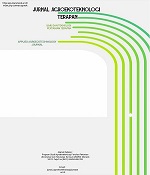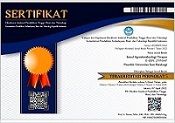Agroforestry Patterns In Wanga Village, East Motoling District, South Minahasa Regency
DOI:
https://doi.org/10.35791/jat.v4i1.46705Abstract
This study aims to describe the agroforestry patterns implemented by the farmers of Wanga Village, East Motoling District, South Minahasa Regency, in this study the method used was a survey method and the determination of respondents was carried out by purposive sampling. The criteria for respondents in this study were farmers who were born and live in Wanga Village and have land managed with an agroforestry system. The results showed that the agroforestry patterns applied by the farmers in Wanga Village were agrisilviculture, agrosilvofishery, and agrosilvopastura. Based on the number of respondents who applied it, the pattern of agroforestry that was most prevalent in the study locations was agrisilviculture with 27 respondents, while agrosilvofishery was only 2 respondents and agrosilvopastura. The results showed that the agroforestry patterns applied by the farmers in Wanga Village were agrisilviculture, agrosilvofishery, and agrosilvopastura. Based on the number of respondents and the area of land that applies the agroforestry pattern, the most common pattern in the research location is agrisilviculture with 27 respondents with a land area of 42 ha, while agrosilvofisheri is only 2 respondents with a land area of 3 ha and agrosilvopastura is only 1 respondent with a land area of 1 ha . The cropping pattern applied to each crop on the entire farmer's land is a random pattern, regular pattern and group pattern with a total of 26 species. plant. In the agrosilvofishery, the types of fish that are kept are Oreochromis niloticus, Oreochromis mossambicus, Cyprinus carpio, and ornamental fish. The type of livestock kept on agrosilvopastura land is pigs. was only 1 respondent. . The cropping pattern applied to each crop on the entire farmer's land is a random pattern, regular pattern and group pattern with a total of 26 species. plant. In the agrosilvofishery, the types of fish that are kept are Oreochromis niloticus, Oreochromis mossambicus, Cyprinus carpio, and ornamental fish. The type of livestock kept on agrosilvopastura land is pigs.
Keywords: Agroforestry; Agrisilviculture; Agrosilvopasture; Silvofishery
Abstrak
Penelitian ini bertujuan untuk mendeskripsikan pola agroforestri yang diterapkan oleh petani Desa Wanga Kecamatan Motoling Timur Kabupaten Minahasa Selatan, dalam penelitian ini metode yang digunakan adalah metode survei dan penentuan responden dilakukan dengan purposive sampling. Kriteria responden dalam penelitian ini adalah petani yang lahir dan tinggal di Desa Wanga serta memiliki lahan yang dikelola dengan sistem agroforestry. Hasil penelitian menunjukkan bahwa pola agroforestri yang diterapkan petani di Desa Wanga yaitu agrisilvikultur, agrosilvofishery dan agrosilvopastura. Berdasarkan jumlah responden dan luas lahan yang menerapkan pola agroforestri, maka pola yang paling banyak di lokasi penelitian adalah agrisilvikultur sebanyak 27 reponden dengan luas lahan 42 ha, sedangkan agrosilvofisheri hanya 2 responden dengan luas lahan 3 ha dan agrosilvopastura hanya 1 responden dengan luas lahan 1 ha. Pola tanam yang diterapkan untuk setiap tanaman pada seluruh lahan milik petani adalah pola acak, pola teratur dan pola kelompok dengan total 26 jenis. tanaman. Di lahan agrosilvofishery jenis ikan yang dipelihara adalah Oreochromis niloticus, Oreochromis mossambicus, Cyprinus carpio, dan ikan hias. Jenis ternak yang dipelihara di lahan agrosilvopastura adalah babi.
Kata kunci: Agroforestri, Agrisilvikultur, Agrosilvopastura, Silvofisheri
Downloads
Published
How to Cite
Issue
Section
License
Copyright (c) 2023 Melizha R.C. Oping, Semuel Ratag, Euis F.S. Pangemanan

This work is licensed under a Creative Commons Attribution-NonCommercial 4.0 International License.

This work is licensed under a Creative Commons Attribution-NonCommercial 4.0 International License.




















